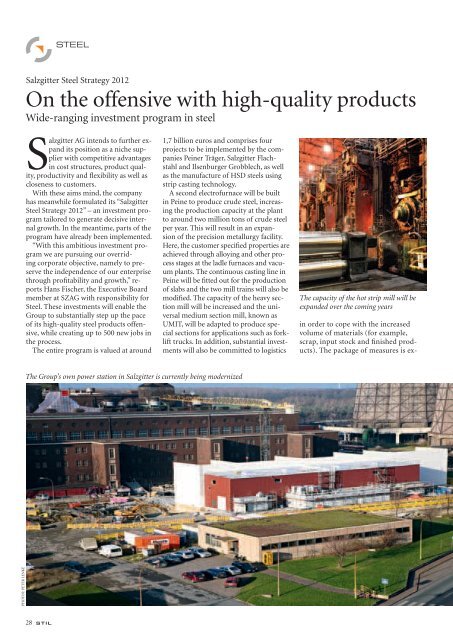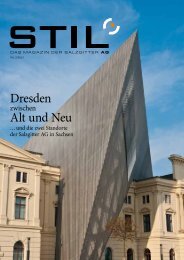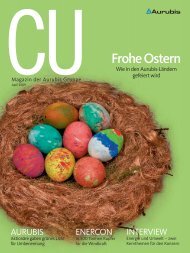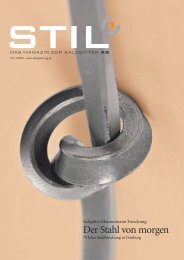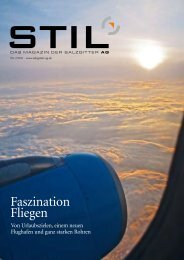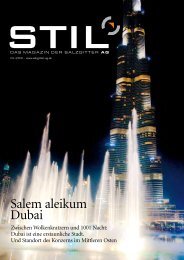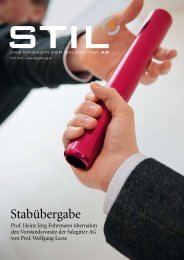Dr. Heinz Jörg Fuhrmann - Schau Verlag Hamburg
Dr. Heinz Jörg Fuhrmann - Schau Verlag Hamburg
Dr. Heinz Jörg Fuhrmann - Schau Verlag Hamburg
Create successful ePaper yourself
Turn your PDF publications into a flip-book with our unique Google optimized e-Paper software.
PHOTOS: PETEr LEnkE<br />
steel steel<br />
Salzgitter Steel Strategy 2012 “We are increasing<br />
On the offensive with high-quality products<br />
Wide-ranging investment program in steel<br />
Salzgitter AG intends to further expand<br />
its position as a niche supplier<br />
with competitive advantages<br />
in cost structures, product quality,<br />
productivity and flexibility as well as<br />
closeness to customers.<br />
With these aims mind, the company<br />
has meanwhile formulated its “Salzgitter<br />
Steel Strategy 2012” – an investment program<br />
tailored to generate decisive internal<br />
growth. In the meantime, parts of the<br />
program have already been implemented.<br />
“With this ambitious investment program<br />
we are pursuing our overriding<br />
corporate objective, namely to preserve<br />
the independence of our enterprise<br />
through profitability and growth,” reports<br />
Hans Fischer, the Executive Board<br />
member at SZAG with responsibility for<br />
Steel. These investments will enable the<br />
Group to substantially step up the pace<br />
of its high-quality steel products offensive,<br />
while creating up to 500 new jobs in<br />
the process.<br />
The entire program is valued at around<br />
1,7 billion euros and comprises four<br />
projects to be implemented by the companies<br />
Peiner Träger, Salzgitter Flachstahl<br />
and Ilsenburger Grobblech, as well<br />
as the manufacture of HSD steels using<br />
strip casting technology.<br />
A second electrofurnace will be built<br />
in Peine to produce crude steel, increasing<br />
the production capacity at the plant<br />
to around two million tons of crude steel<br />
per year. This will result in an expansion<br />
of the precision metallurgy facility.<br />
Here, the customer specified properties are<br />
achieved through alloying and other process<br />
stages at the ladle furnaces and vacuum<br />
plants. The continuous casting line in<br />
Peine will be fitted out for the production<br />
of slabs and the two mill trains will also be<br />
modified. The capacity of the heavy section<br />
mill will be increased and the universal<br />
medium section mill, known as<br />
UMIT, will be adapted to produce special<br />
sections for applications such as forklift<br />
trucks. In addition, substantial investments<br />
will also be committed to logistics<br />
The capacity of the hot strip mill will be<br />
expanded over the coming years<br />
in order to cope with the increased<br />
volume of materials (for example,<br />
scrap, input stock and finished products).<br />
The package of measures is ex-<br />
pected to be completed by 2010.<br />
In Salzgitter the production of pig iron<br />
will be optimized. In addition, a fourth<br />
continuous casting line will be built to<br />
produce thick slabs up to 350 mm. The<br />
precision metallurgy facility will be expanded,<br />
and the capacity of the hot<br />
wide strip mill will be increased to<br />
4.5 million tons. Meanwhile, Ilsenburg<br />
will benefit from several smaller<br />
investments in the plate mill.<br />
A decisive step towards a new form<br />
of rolled steel production will be taken<br />
with the introduction of Belt Strip<br />
Technology (BeST). A pilot plant is<br />
to be built in Peine for continuous<br />
strip casting which will put the experience<br />
gained by the Salzgitter Mannesmann<br />
Forschung research unit in cooperation<br />
with the Clausthal University<br />
of Technology into practice in an industrial<br />
context. The process involves<br />
pouring liquid steel horizontally direct<br />
from the ladle to form a thin strip.<br />
The strip is then rolled directly to produce<br />
finished hot strip, which can then<br />
be processed into cold-rolled strip as<br />
required. The decisive advantages of<br />
the process include the omission of entire<br />
production stages and the ability<br />
to produce innovative grades of steel,<br />
among them HSD (High Strength and<br />
Ductility) steels. As their name implies,<br />
these high-manganese steels developed<br />
in cooperation with Corus are distinguished<br />
by high strength coupled with<br />
high ductility. HSD steels have been<br />
developed for numerous applications<br />
which typically combine complex geometric<br />
shapes with a need for great<br />
strength. The new plant is targeted to<br />
produce the first HSD steels by the end<br />
of 2009.<br />
Salzgitter AG has already implemented<br />
one extensive program of investment<br />
in plant and processes during<br />
the period from 2000 to 2006. Among<br />
the important elements of this program<br />
were the development of surface<br />
treatment with the construction of a<br />
new strip coating plant and a second<br />
hot-dip galvanizing plant, an initial<br />
modernization of the hot wide strip<br />
mill, the recommissioning of blast furnace<br />
C, a third continuous casting line,<br />
a beam blank plant in Peine and an intensive<br />
cooling plant and a cold leveler<br />
in Ilsenburg.<br />
Currently, the power station in<br />
Salzgitter is undergoing complete<br />
modernization and a continuous pickling<br />
line and hot strip cut-to-length<br />
line are under construction, among<br />
other projects.<br />
The Group’s own power station in Salzgitter is currently being modernized The existing electrofurnace in Peine will be joined by a second unit<br />
integration<br />
within the Group”<br />
With its “Salzgitter Steel 2012” strategy,<br />
the Steel Division of Salzgitter AG aims to<br />
take a decisive step forward in terms of<br />
growth. stil international talked to<br />
Hans Fischer, Executive Board member<br />
Steel, about the most important changes.<br />
stil By 2012, the Steel Division<br />
of Salzgitter AG aims to take a<br />
decisive step forward in terms<br />
of growth. Which are the most<br />
significant individual projects?<br />
hans fischer The overall<br />
“Salzgitter Steel 2012” project<br />
is divided into the four subprojects<br />
PTG 2010, SZFG<br />
2012, ILG 2010 and HSD Steels/Thin Strip<br />
Casting. With the construction of a second<br />
electrofurnace, crude steel capacity at Peiner<br />
Träger GmbH (PTG) will increase to around<br />
two million tons per year. In addition to<br />
input stock for beam production, the works<br />
will then also turn out slabs for customers<br />
such as Group member HSP Hoesch Spundwand<br />
und Profil GmbH, enabling us to<br />
reduce the quantity of slabs bought in for<br />
sheet pile production.<br />
stil What are the strategic objectives behind<br />
these investments?<br />
fischer This strategy is another step on the<br />
road towards differentiating the Salzgitter Steel<br />
Group from its competitors. We are broadening<br />
our product variety and pursuing our strategic<br />
decision to manufacture higher quality<br />
steels. At the same time, by introducing new<br />
technical facilities, we are increasing our flexibility<br />
and enhancing production capacity. The<br />
Salzgitter Group regards itself as a niche player.<br />
Our strategy is not one of dominance, we<br />
prefer to concentrate on close customer loyalties,<br />
proximity to the markets and flexibility.<br />
stil How do we differ from the competition?<br />
fischer These investments will increase the<br />
already high level of integration within the<br />
Group as the individual companies become<br />
even more closely harmonized with one<br />
another. Our research unit Salzgitter Mannesmann<br />
Forschung has a decisive role to play in<br />
this context. This unit combines the Group’s<br />
research and development competence, and<br />
dovetails closely with the manufacturing companies.<br />
Solutions are developed in a process of<br />
tight-knit cooperation, which involves Technical<br />
Consulting as well as our customers and<br />
university partners.<br />
28 stil stil 29


